Field School
-
Upcoming Field School
-
History
-
Field School Scholarship
-
Testimonials
Explore America’s Past at Historic St. Mary’s City
2024 Field School in Historical Archaeology
Historic St. Mary’s City, Maryland
Historic St. Mary’s City (HSMC), in association with St. Mary’s College of Maryland (SMCM), announces its 2024 Field School in Historical Archaeology. The 2024 field season will be focused on St. Mary’s Fort, the site of Maryland’s founding. St. Mary’s Fort was a large, palisaded fort constructed by the first wave of European colonists who arrived in Maryland in the spring of 1634. St. Mary’s Fort represented the first major foothold of European settlement in Maryland. Its discovery and interpretation are critical to understanding the early period of indigenous-colonial relations, a period that is not well-documented historically or archaeologically. This project also offers the opportunity to reflect on the nature of historical colonialism in Maryland and its continuing effects in today’s world.
Excavations during the 2024 season will be focused on the western bastion and nearby palisade walls in an effort to learn more about the fort’s architecture.
Program Dates:
May 13 – June 21
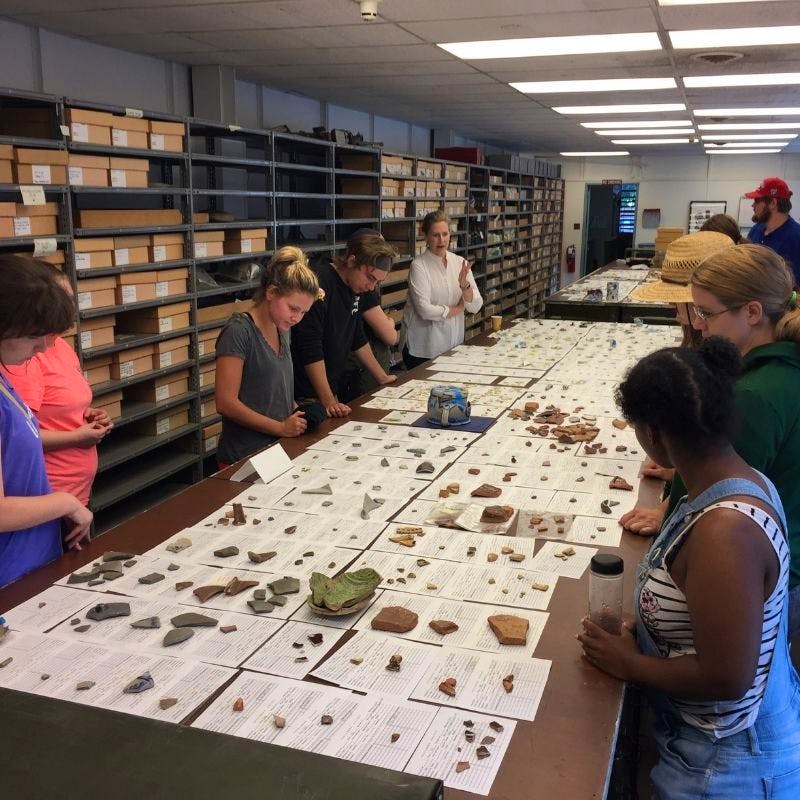 Field School Program
Field School Program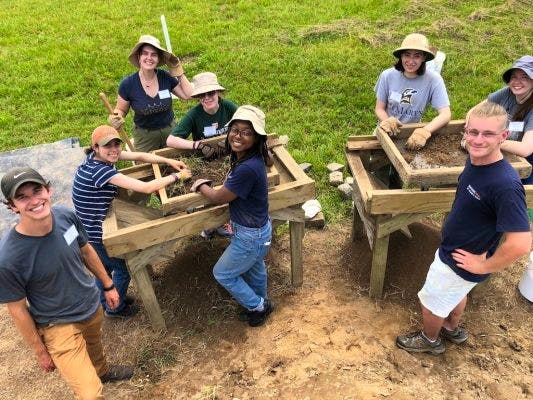 Field School Program
Field School ProgramAbout the Program
HSMC is a state-supported, outdoor museum located at the site of Maryland’s first capital (1634–1694). The HSMC field school one of the longest-running historical archaeology field schools in the United States. Participants engage in an immersive six-week program that teaches the foundational principles of historical archaeology through hands-on excavation, laboratory work, and artifact analysis. Students learn artifact identification by working with one of the best archaeological collections of indigenous, colonial, and post-colonial material in the country.
The Field School in Historical Archaeology is an ideal experience for undergraduate or graduate students concentrating in Anthropology, Archaeology, History, Museum Studies, or American Studies, or for any student with an interest in learning about the past through archaeology.
Requirements
No prior archaeological experience is required for acceptance into the field school. An introductory course in anthropology, archaeology, and/or colonial history will be helpful, but is not mandatory. Archaeological fieldwork is physically demanding and requires strong communication skills; the ability to engage in sustained, strenuous teamwork is essential.
Tuition and Fees
Although the HSMC Historical Archaeology Field School is accredited through St. Mary’s College of Maryland (SMCM), a state honors college dedicated to the Liberal Arts, the field school program is open to students from any institution that accepts transferable credit. Undergraduate students may register for either Anthropology or History credits. Tuition for the four-credit program is as follows:
MD/DC Tuition
4 credits @ $348.50 per credit = $1,394
Non-MD Tuition
4 credits @ $498.50 per credit = $1,994
An additional fee of $75 is assessed to cover the costs of field trips, materials, and a commemorative T-shirt for each participating student. Graduate students should contact Director of Research and Collections Travis Parno (travis.parno@maryland.gov) to discuss accreditation options.
The Pathways to Archaeology Field School Scholarship (PTAFSS) is available for students from historically underrepresented groups in archaeology. Contact travis.parno@maryland.gov for more information.
Room and Board
Housing in SMCM dormitories is available to students at a reduced rate on a first-come-first-served basis. Housing includes access to free wi-fi and laundry facilities. Students housed on campus may also enroll in one of several meal plan options available on SMCM’s campus. HSMC is within walking distance from SMCM’s campus. Transportation assistance is available for out-of-state students. Students seeking housing are encouraged to apply early. Contact travis.parno@maryland.gov for information about reserving a room or enrolling in a meal plan.
How to Apply
To apply, please submit an application that includes the following components to the email address listed below:
1. A one-page personal statement that describes your interest in the course and your academic background, including your expected graduation date and any previous courses, experiences, or special skills relevant to your participation in the field school.
2. A resume or curriculum vitae that includes your contact information (both mailing addresses and phone numbers) for your university and permanent residences.
3. Contact information (including professional title, mailing address, and email address) of two academic references.
Application documents should be submitted electronically in .doc, .docx, or .pdf format to travis.parno@maryland.gov.
Application Deadline: April 7, 2024
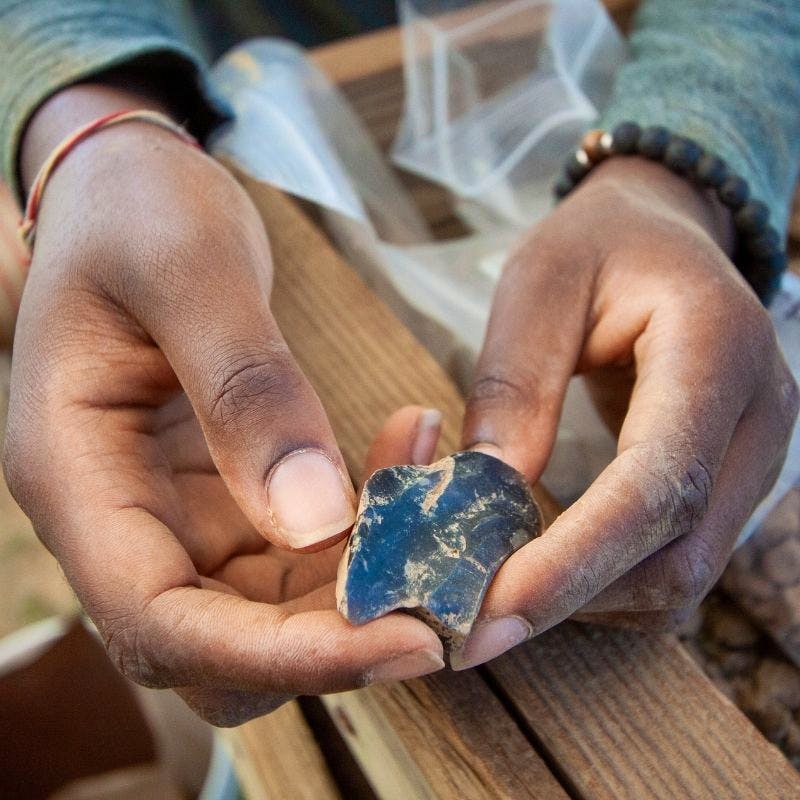 Field School Program
Field School Program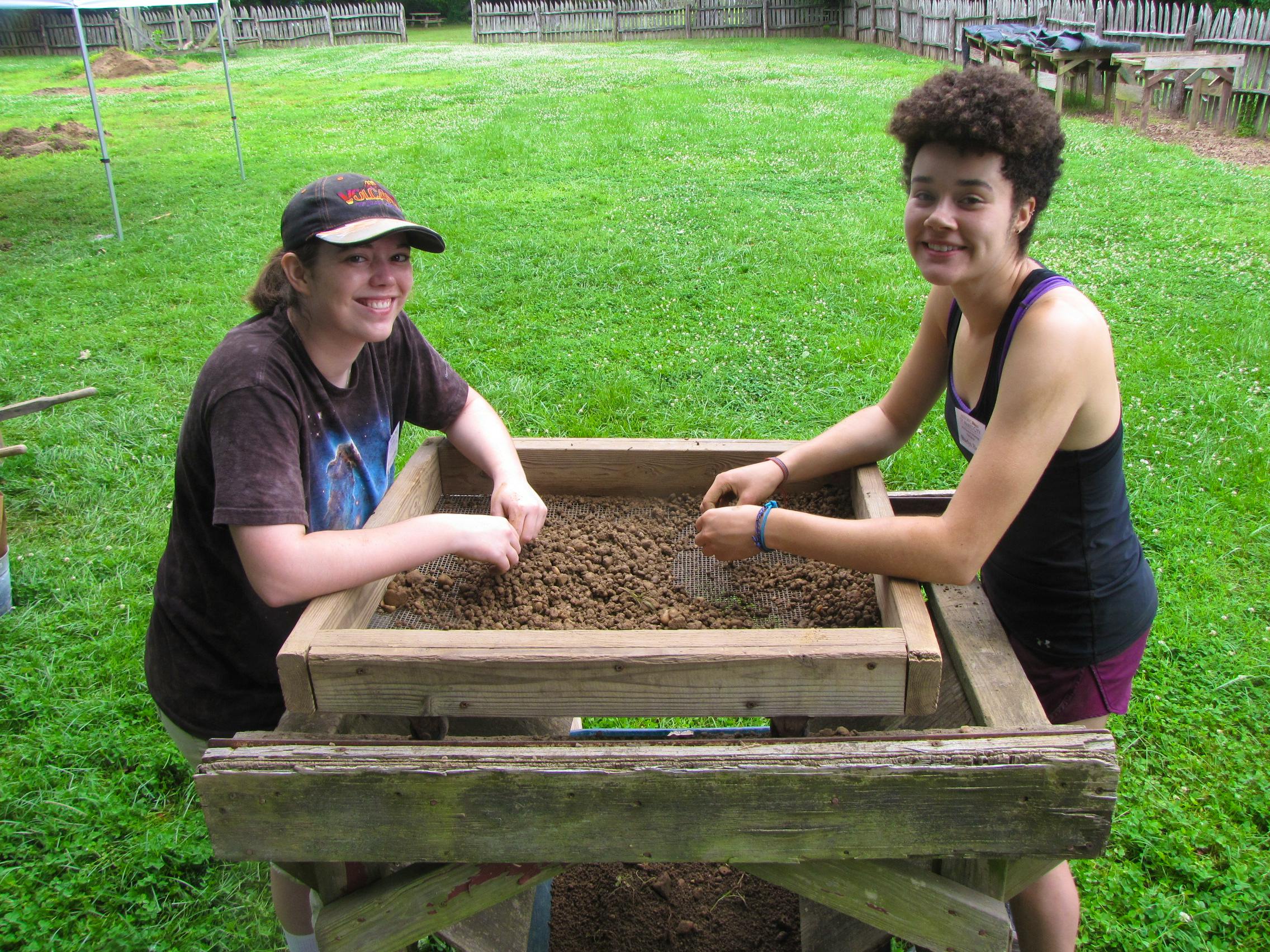 Field School Program
Field School ProgramA Brief History of the Historic St. Mary’s City
Field School in Historical Archaeology
Teaching students the art of archaeology has a very long history at Historic St. Mary’s City (HSMC). It is one of the earliest training programs in historical archaeology offered in the United States, beginning in 1971. In that year, the museum’s first archaeologist, Garry Wheeler Stone, in collaboration with St. Mary’s College of Maryland (SMCM), offered a summer training session. They investigated the lawn of the rebuilt 1676 State House, and located prehistoric and colonial features as well as evidence of a buried ravine. Later that summer, they began exploring a depression on a nearby property that was hoped to be a 17th-century site. Instead, it proved to be an 18th-century house known as Pope’s Freehold, with a cellar full of 19th-century trash.Field School Program
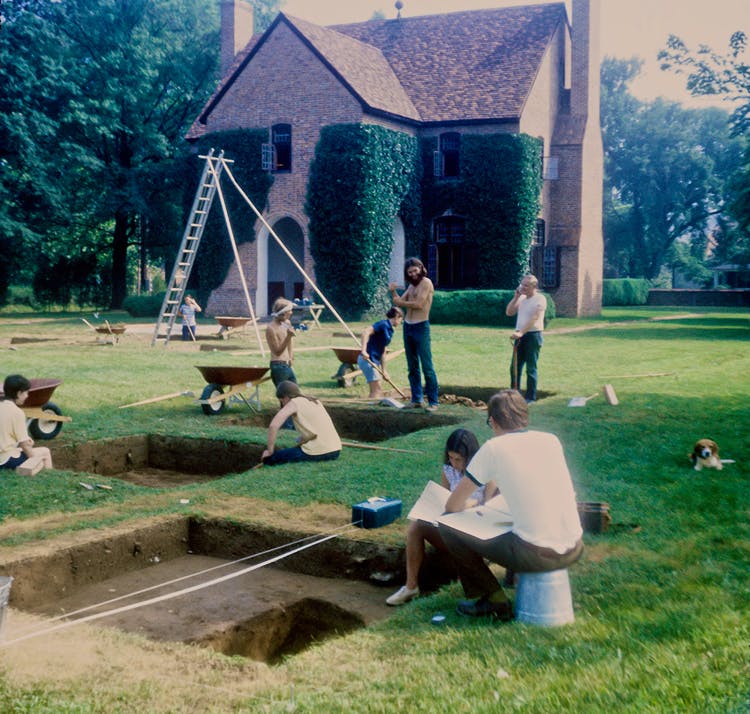 The 1971 Field School digging in front of the Reconstructed State House
The 1971 Field School digging in front of the Reconstructed State HouseA greatly expanded program was offered in 1972. This research was a collaborative effort between HSMC, SMCM, George Washington University and the Smithsonian Institution in a 10 week session, with support from National Endowment for the Humanities and National Science Foundation grants. Excavations resumed at Pope’s Freehold to complete the excavation and record the 18th-century building. Attention next turned to the St. John’s site, the first major 17th-century site explored with modern archaeological methods in Maryland. It was built in 1638 and was inhabited into the early 18th century.
This field school included undergraduate and graduate students working with a crew of paid excavators. The students received lectures on the latest work from leading scholars, including Dr. Lois Green Carr and Russell Menard (documentary research), Dr. Cary Carson (architectural history), Dr. Wilburn Washburn (Chesapeake history), and Dr. Stone (archaeological methods). Topics covered included artifacts, demography, the tobacco economy, the study of probate inventories, British and colonial architecture, and the story of Maryland’s founding and its first capital.
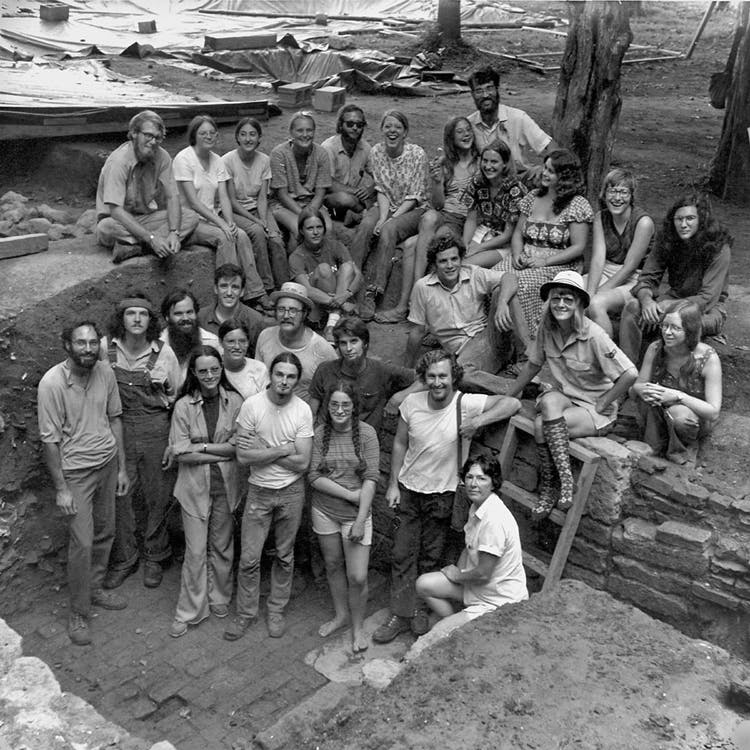 The 1974 Field School in the cellar of St. John’s
The 1974 Field School in the cellar of St. John’sThe St. John’s work spanned the summers of 1972–1975, with more limited work in 1976. The grants concluded in 1975. In 1974, a portion of the field school was assigned the task of beginning work on another early site known as the Van Sweringen Council Chamber Inn. It was the most elegant inn in the colony and portions of the site had been uncovered and exhibited to the public during the celebration of Maryland’s 300th birthday in 1934. This was the first public display of a colonial archaeological site in the state. Excavations continued on the site during the late 1970s, uncovering the main buildings, an adjacent kitchen with its intact brick floor, and a small wine cellar
Work at the Van Sweringen site in 1979 and 1980 also involved training in site discovery. To enhance the students’ experience, archaeologist Michael Smolek, then a regional archaeologist for the Maryland Historical Trust, worked with field school students to conduct a survey to find archaeological sites in nearby areas such as St. Inigoes and Newtown in St. Mary’s County. This not only allowed a large number of new sites to be discovered, but gave students valuable experience in site identification and the procedures needed to record sites in the state’s archaeological data base.
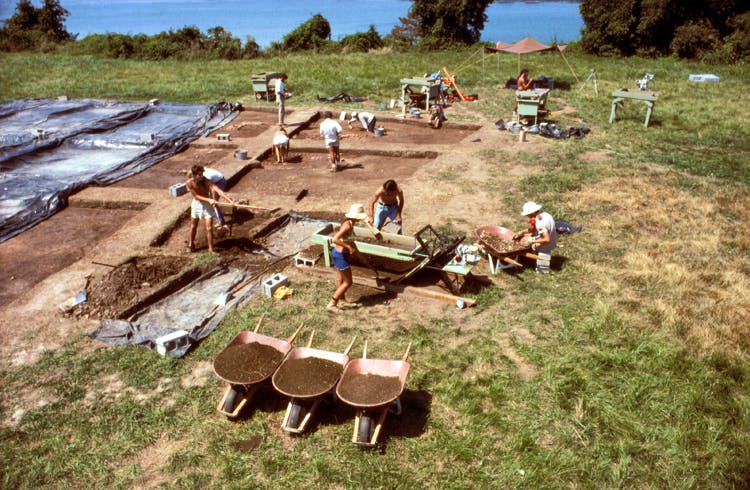 Field School excavations at the Van Sweringen Site,1974–1975
Field School excavations at the Van Sweringen Site,1974–1975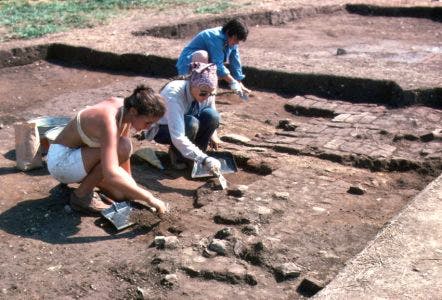 Field School excavations at the Van Sweringen Site,1974–1975
Field School excavations at the Van Sweringen Site,1974–1975The summer of 1980 saw a new relationship begin when HSMC’s field school joined forces with Dr. Mark Leone of the University of Maryland and conducted a joint field school at the Van Sweringen site. The landscape of this 17th-century inn was explored through archaeological sampling. This began a productive five year partnership with the state’s premier academic institution.
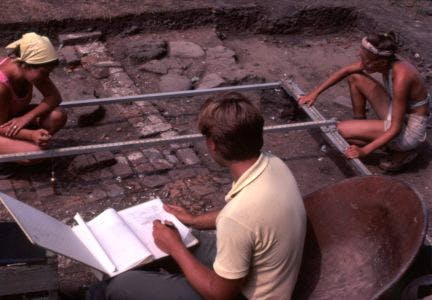 Mapping the foundations of the Calvert House, home of Maryland’s first governor and the colony’s first State House, 1983
Mapping the foundations of the Calvert House, home of Maryland’s first governor and the colony’s first State House, 1983A grant from the National Endowment for the Humanities (NEH) in 1981 saw the HSMC Field School and University of Maryland Field School initiate a major project that had the goal of finding the center of the long-vanished city. Digging several hundred five-by-five foot units in a stratified random pattern, the students and some paid crew sampled the study area and found many structures, including the first governor’s house, a moated fort dating to the 1640s, Smith’s Ordinary, a store called Cordea’s Hope, and a number of other buildings. The center of the city was finally identified. The field work was led by Dr. Stone, Alexander H. Morrison, and Fraser Neiman, and the overall NEH project was directed by Henry Miller. Smaller sessions with SMCM were conducted in 1986 and 1987 under the co-direction of Miller and Timothy Riordan. The latter work focused largely upon the 1640’s Pope’s Fort, while Leone and the University of Maryland began its celebrated program of investigating Maryland’s other capital city with Archaeology in Annapolis.
A new project by the museum caused the 1988 field school students to turn their efforts to the Chapel Field, seeking to uncover the foundations of Maryland’s first major brick building—the 1660s Brick Chapel. This work continued in 1989 and 1990 under Riordan’s direction and the project was expanded by another NEH grant. Work in the early 1990s by the field school explored the chapel area, leading to the discovery of many human graves, as well as the Priest’s House next to the Chapel (the Priest’s House’s brick-filled cellar was also tested during this season). This work provided critical evidence to inform the reconstruction of the chapel.
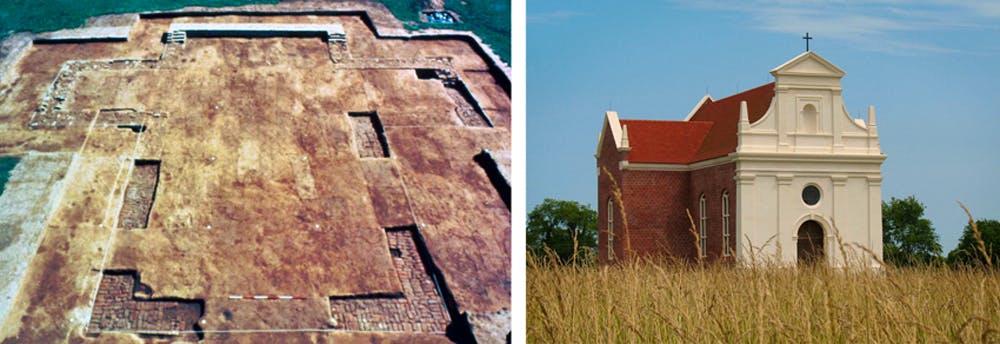 Foundations of the 1660s Chapel as uncovered by the Field School (left) and its Reconstruction (right)
Foundations of the 1660s Chapel as uncovered by the Field School (left) and its Reconstruction (right)The 1992 season also saw testing of sites in the Mill Field, near the original land entrance to the city. That year was especially busy because it involved preparing the area for a large scale scientific project that would investigate three 17th-century lead coffins buried within the chapel, a discovery originally made by field school students in 1989. This internationally reported investigation uncovered and raised each coffin, opened them, and permitted a range of scientists to study the remains. The results were reported in 1994 with the identification of the buried individuals as members of Maryland’s founding family—the Calverts.
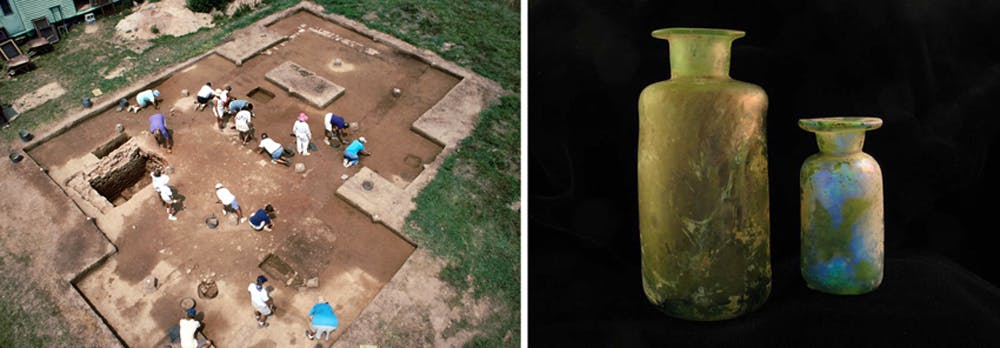 Students excavating the Priest’s House (left) and small bottles found amazingly intact among the jumbled brick rubble that filled the cellar of the Priest’s House (right)
Students excavating the Priest’s House (left) and small bottles found amazingly intact among the jumbled brick rubble that filled the cellar of the Priest’s House (right)Other work in the 1990s included excavations around the 1840s Brome Plantation in preparation for it being relocated and survey activity by controlled surface collection and the testing of sites identified in the core historic area known as Governor’s Field. In 1996, the field school helped explore a previously unknown building near the Van Sweringen site that the British televisions series TIME TEAM had discovered during the filming of a show at the museum in May of that year.
The early 21st century saw the field school begin work on the Print House site. This had been the location of a group of 1840’s slave quarters of the Brome Plantation. Survey and testing had unexpectedly recovered 17th-century printing type there. Excavators found a 17th-century building directly under one of the 1840s quarters. It was a building used by Maryland’s first printer, William Nuthead. Field school participants sampled the area and help dig features from both the 17th-century building and the 19th-century slave quarter, recovering a rich sample of artifacts associated with 17th-century colonists and enslaved and emancipated African Americans during the 1840–ca.1940 time period. The evidence collected was essential to inform the reconstruction of the Print House as an exhibit and the completion of a doctoral dissertation on African American life at St. Mary’s City.
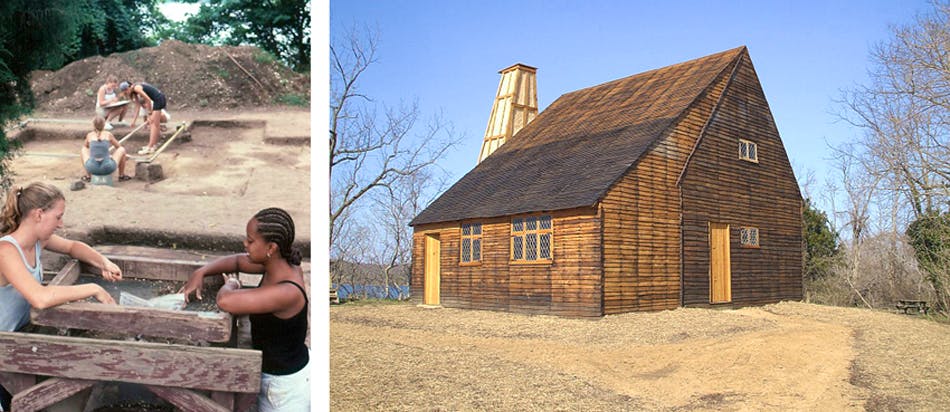 Field school students digging at the Print House Site in 2000 (left) and the reconstruction of the building in 2005 (right)
Field school students digging at the Print House Site in 2000 (left) and the reconstruction of the building in 2005 (right)Students returned to the St. John’s site in 2004 to assist in preparing it for construction of a major exhibit building that would cover the well-preserved foundations of this highly significant 1638 building. In 2005, field school students collected more information from the Van Sweringen site so that a new exhibit could be constructed over the ruins of its Council Chamber. The next season, students tried to find the house of John Morecroft, described by Governor Charles Calvert as the best lawyer in Maryland.
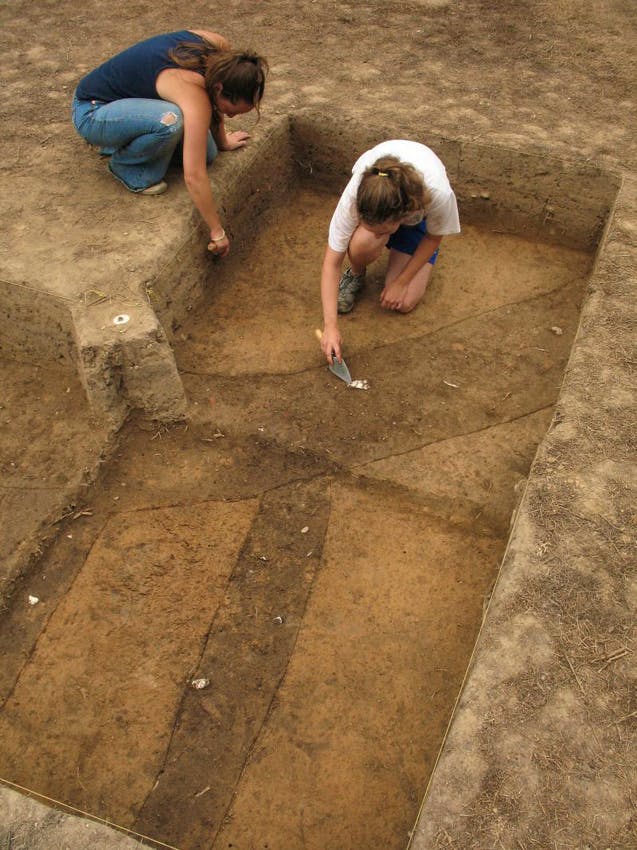 17th-century fence lines being uncovered by field school students at the Calvert House
17th-century fence lines being uncovered by field school students at the Calvert HouseBeginning in 2008, the museum began a sustained effort to more fully investigate the landscape and outbuildings associated with the Calvert House, Maryland’s first state house. This involved digging test pits, mapping fence lines, and excavating fence features to date them and determine how they were constructed. Outbuildings were also located, including a dairy whose cellar was investigated. Perhaps the most unusual find is a possible animal fighting ring in the back yard of the Calvert House. The findings from the Calvert House have formed the basis for one doctoral dissertation and offer the potential for much more research. These excavations continue under the direction of Dr. Travis Parno with the Calvert Site scheduled to become a major museum exhibit by the early 2020s. To see what some of the recent field schools have been discovering, check out our “Dispatches from the Field School” blog.
Since it began, the HSMC Field School has been 10 weeks in duration. It is longer than most field schools because we wish students to complete their field experience having solid skills and confidence in their understanding of how field archaeology is conducted. There is a big difference between just barely grasping the basics and feeling confident that one understands and can proficiently perform professional excavations. This confidence can only come from doing excavations and recording evidence for a sustained period of time. But the longer session also allows us to give students a deeper experience of colonial history and archaeology.
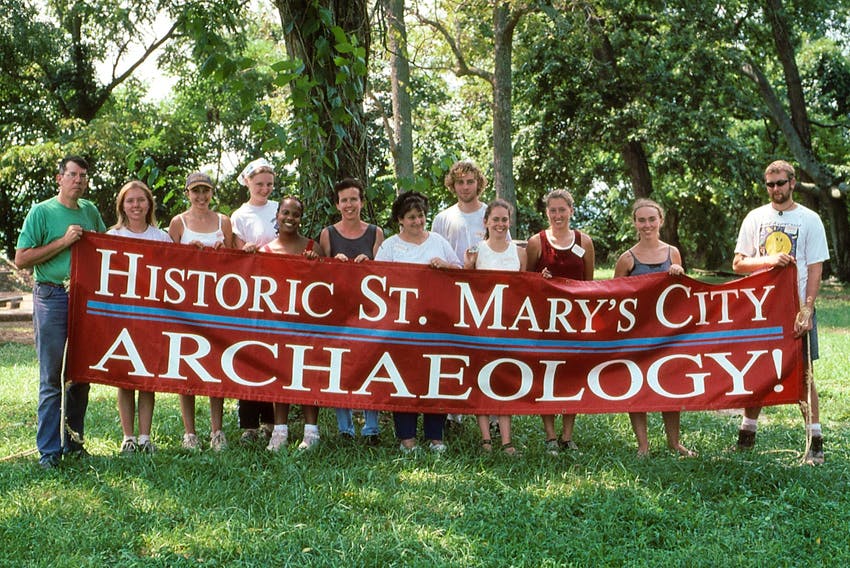 The Field School in 2000
The Field School in 2000Every student spends time in the laboratory, learning artifact processing procedures and studying some of the materials being found at the site. Each student attends lectures about, and hands-on experience with, all the main artifact groups found on Eastern United States sites, while also learning the key artifacts needed to date sites and features. They are given presentations about colonial history, the tobacco economy, and the methods used to locate archaeological sites. Seventeenth-century probate inventories are explored to better understand what past peoples owned and how their material culture is (or is not) represented in the archaeological record. Probate study also helps students learn how material culture varied by wealth in the early colony. A tour of original and reconstructed architecture is provided to explore architectural history and understand the connection between the features being uncovered on an archaeological site and the buildings that once stood there. Students also have a series of guest speakers who talk about their research at other sites and on topics ranging from the archaeological excavation of shipwrecks to the analysis of colonial human burials. But equally important is learning how to communicate with visitors about archaeology.
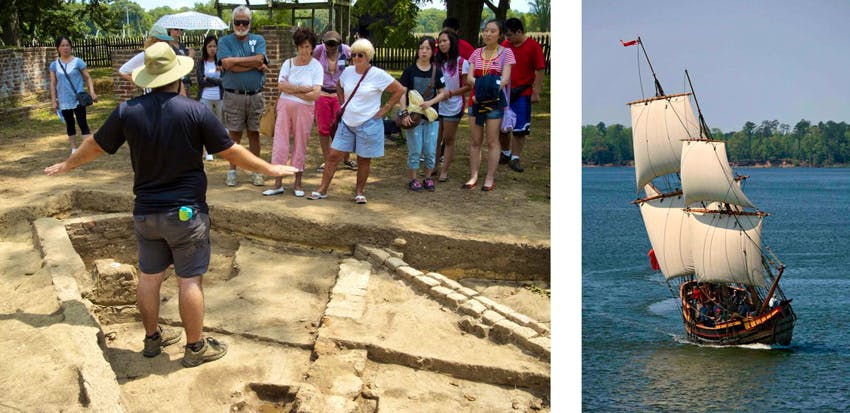 A student giving a site tour (left) and the Maryland Dove under sail on the St. Mary’s River (right)
A student giving a site tour (left) and the Maryland Dove under sail on the St. Mary’s River (right)Public archaeology has been a key aspect of the HSMC Field School since its beginning, with formal tours first offered in 1972. Students are taught how to give guided tours of the excavations in which they explain the site’s history and share the team’s digging methods and discoveries to museum visitors. They also participate in planning and conducting a major annual public archaeology event called Tidewater Archaeology Weekend, which the museum began thirty years ago in 1987.
To broaden their experience, the class visits other public excavations in Maryland and Virginia and historically significant museums such as Jamestown and Williamsburg on field trips. Finally, each student has the rare opportunity to learn about, sail on, and help operate one of HSMC’s exhibits: an authentic reconstruction of a 17th-century square rigged pinnace, The Maryland Dove. This field school is a unique academic experience that allows students to better learn about the past, how it can be explored, and how they can share their discoveries with others.
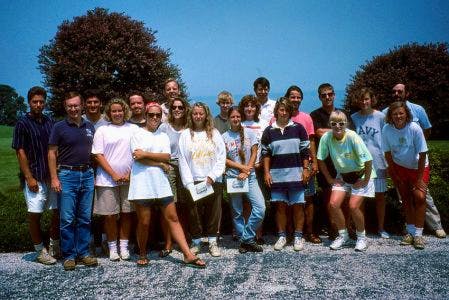 The Historic St. Mary’s City Field School touring Jamestown in 1990
The Historic St. Mary’s City Field School touring Jamestown in 1990The Historic St. Mary’s City Field School in Historical Archaeology is one of the oldest ongoing programs of its type in North America. It has trained generations of students who now teach in colleges and universities, or work in private, state, and national museums, government agencies, cultural resource managements companies, and other businesses. HSMC Field School graduates are found throughout the United States and Canada, in England, and in other parts of the world. Among the field school alumni who have pursued careers in archaeology are Joanne Bowen, Alasdair Brooks, Virginia Busby, Susan Henry, Audrey Horning, Matthew Reeves, Michelle Sivilich, Brent Wiseman, and Wes Willoughby. To read what former students had to say about their experiences at the HSMC Field School, head to the “Looking Back and Thinking Forward” page.
–By Henry M. Miller, March 2017
Pathways to Archaeology Field School Scholarship
The Pathways to Archaeology Field School Scholarship is available to students from historically underrepresented groups in archaeology. The scholarship provides tuition for the field school program, housing in a dormitory at St. Mary’s College of Maryland, and a $2,500 stipend.
Download the 2024 Pathways to Archaeology Field School Scholarship form here.
Eligibility Requirements
1. You must be a member of historically underrepresented groups in archaeology, including but not restricted to African American, Hispanic/Latino, Asian American, Native peoples of the Americas, Alaska Natives, Native Hawaiians, Indigenous Pacific Islanders, and other non-European minorities.
2. You must be a citizen or resident of either the U.S. or Canada.
3. At the time of application, you must be one of the following:
(A) enrolled in a regionally accredited university in the United States or Canada, or if outside the United States, a university with equivalent accreditation.
(B) a recent graduate with a documented plan to attend graduate school in the next academic year.
(C) a graduate student in Year 1 or Year 2 of graduate studies.
Deadline and Submission
Applications include an application form, personal statement, and two letters of recommendation. Guidelines for the personal statement are included in the application form. Applications, including letters of recommendation, are due on or before April 14, 2023.
Recommendation Letters
Two letters of recommendation from individuals familiar with your academic or work background, such as professors or supervisors. Recommenders should email their letters to travis.parno@maryland.gov on or before the application deadline.
Additional Information
Scholarship awardee(s) will receive a check for the stipend amount from the Historic St. Mary’s City Foundation. Field school tuition and housing costs will be paid directly to St. Mary’s College of Maryland.
Applicants are critically evaluated to understand their interest in archaeology and their proposed program of study, their previous accomplishments, and the contributions the applicant hopes to make to the discipline’s future. Scoring is based on the completeness of the application and the coherence and clarity of the personal statement and compelling letters of recommendation about the applicant’s past successes and future potential.
Documentation Requirements
At the conclusion of the field school program, scholarship awardee(s) are required to write an impact statement describing their experience in the program. The statement should be one page (single-spaced, 12 pt. font). Photographs can be attached. This statement is due one month after the conclusion of the field school. HSMC reserves the right to use these statements and photographs of awardee(s) to promote the scholarship program.

Field School Program
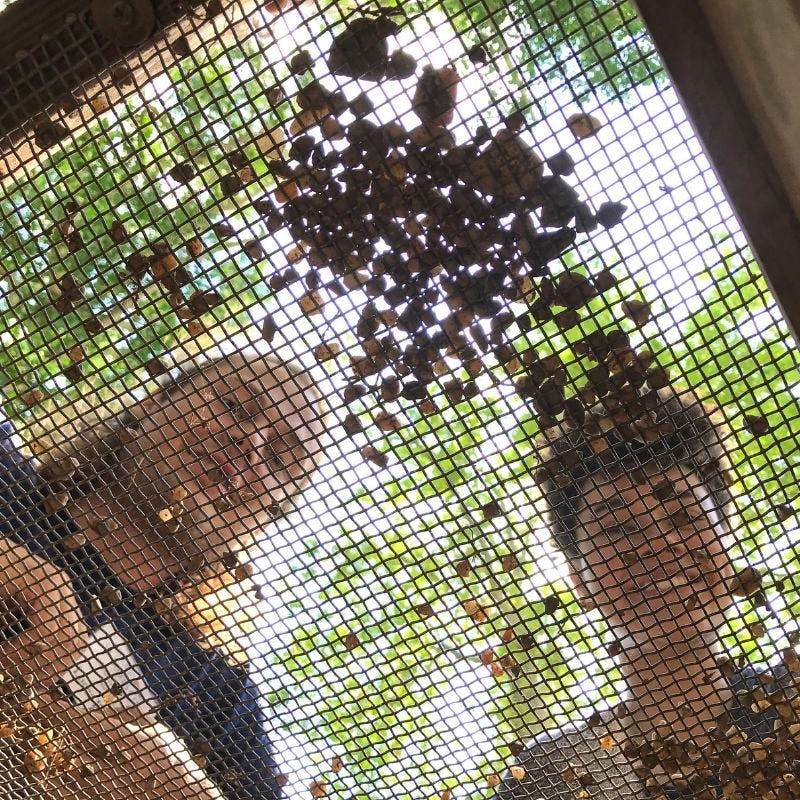 Field School Program
Field School ProgramLooking Back and Thinking Forward
Read what former students had to say about their experiences at the HSMC Historical Archaeology
Field School…
